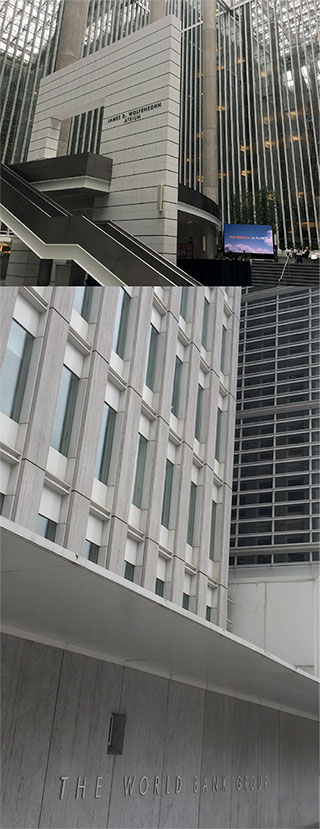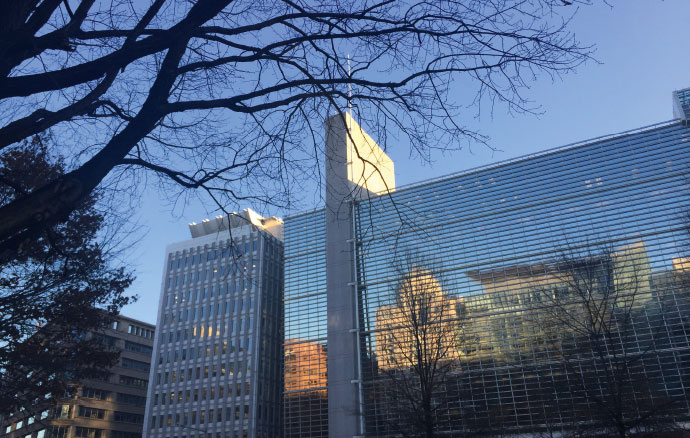Danube Watch 3/2017 - FACTS: the World Bank
FACTS: the World Bank
 The World Bank was formed in 1944 in New Hampshire, United States with the initial objective of providing finance for the reconstruction of European countries devastated by World War II. Its first loan was to France in 1947, but the bank quickly expanded its activities offering reconstruction support to Latin America, Africa and Asia. In the 1950s and 60s funding for major infrastructure projects, such as dams, electricity grids, irrigation systems and roads, became the bank’s primary focus.
The World Bank was formed in 1944 in New Hampshire, United States with the initial objective of providing finance for the reconstruction of European countries devastated by World War II. Its first loan was to France in 1947, but the bank quickly expanded its activities offering reconstruction support to Latin America, Africa and Asia. In the 1950s and 60s funding for major infrastructure projects, such as dams, electricity grids, irrigation systems and roads, became the bank’s primary focus.
In the 1970s the Bank shifted its attention to the eradication of poverty, and in the 1980s began to focus on issues of social development. By this time the bank had expanded its staff to include not just engineers, economists and financial analysts, but also to experts from a myriad of disciplines including public policy experts, sectoral experts and social scientists.
The World Bank’s twin goals are ending extreme poverty and promoting shared prosperity by investing in effective and sustainable water solutions that enable universal access to sanitation and water, promote water security, and build resilient societies.
Today the Bank is a leader in the field of international development and poverty reduction. It also works alongside, or in support of, governments, institutions and organisations which all share its common goals.
As the world’s largest multilateral source of financing for water in developing countries, the World Bank is committed to achieving the vision of “A Water-Secure World for All”. Under this vision, water is effectively managed as a critical resource for the development of support for agriculture, manufacturing, job creation, private households, and the environment. The Bank’s philosophy is that the entire population should be able to share this limited resource and have access to safe and sustainable sanitation and water services, thereby enabling healthy lives. In a water-secure world, countries are able to reduce and adapt to the impacts of climate change on water, while ensuring that each and every single drop is consumed more efficiently.
The World Bank’s water portfolio currently covers 175 projects worth US $27 billion in lending and technical expertise. Around 70% of lending is for services such as water supply and sanitation and irrigation projects. Since 2014, lending for water resources management has also shown rapid growth, rising to 30% of the portfolio in 2017. In addition, projects with a water sector-related component managed by other global practices of the World Bank total approximately $10 billion, meaning the Bank’s total water-related investments are $37 billion.
Five priority themes have been identified where action is critically needed to achieve the Sustainable Development Goals (SDGs) for water. These themes do not exist in isolation and need to be implemented simultaneously so that actions under each of these themes can mutually reinforce each other and can contribute to the many other SDGs which are so closely interlinked with the achievement of a water-secure world for all:

Sustainability
Sustainability is ultimately about ensuring that available resources today can continue to deliver benefits to future generations. The partnership focuses on two critical aspects: 1) the sustainable management of water resources to secure long-term availability, considering the impacts of population growth, rapid urbanization and climate change; 2) adequately built and maintained infrastructure assets.
Inclusion
Inclusion is the process of improving the terms for both individuals and groups based on their inability to take part in society. Water belongs to everyone and yet many are excluded from its benefits. Ensuring that a project enhances the inclusion agenda therefore requires better knowledge of the nature of water inequality, enhancing the capacity of clients and putting in place incentives to enable better outcomes. This requires strong institutions that have the ability to hold states and service providers accountable.
Institutions
Expanding access to and improving the quality of services can only be achieved and sustained if institutional arrangements provide the right incentives and resources and the organisations tasked with service delivery also have the requisite capacity. Institutions comprise the formal and informal ‘rules of the game’ within which these organisations operate and, through this, affects the quality and sustainability of services. To strengthen institutions and accountability for service provision, the Global Water System Project (GWSP) has been established to understand the rules of the game and incentive structures have been set up to facilitate a pragmatic change process that is grounded in local cultures, economies, and political circumstances.
Financing
The SDGs come with new and very significant financing needs. For water supply and sanitation, they are estimated to be US $1.7 trillion, or three times the amount historically invested in the sector. US $960 billion will be required between 2005/07 and 2050 to ensure water for agricultural production in 93 developing countries. Failure to address water resources management could diminish national growth rates by as much as 6 percent of GDP by 2050. A two-pronged approach is needed to achieve the SDGs on water: 1) improving the financial viability of the water sector to ensure that “water can pay for water” whilst ensuring affordability of services for the poor; 2) leveraging commercial and non-state sources of financing.
Resilience
Management of water resources and water-related services (water and sanitation, irrigation, etc.) will increasingly be subject to shocks in years to come because of increased climate variability and extreme weather events, such as floods and droughts. Resilient solutions call for strategies and tools at country, basin, and project level that are capable of incorporating not only climate and disaster risk consideration, but also innovative solutions to ease water scarcity constraints as well as socioeconomic and environmental considerations. Building climate resilience will require the development of tools and approaches that can help save lives and livelihoods.






